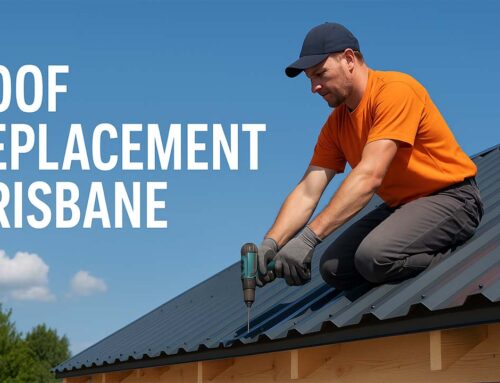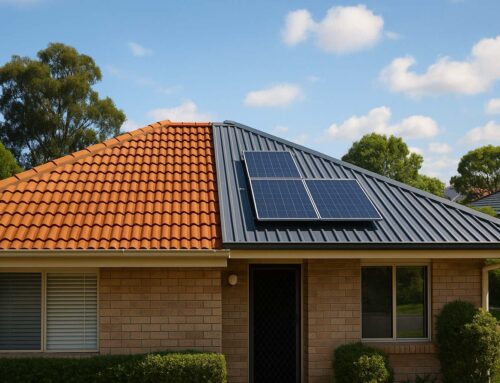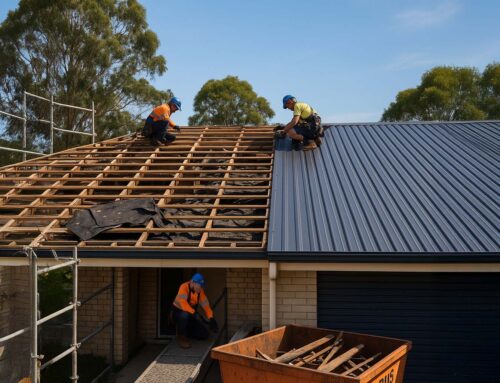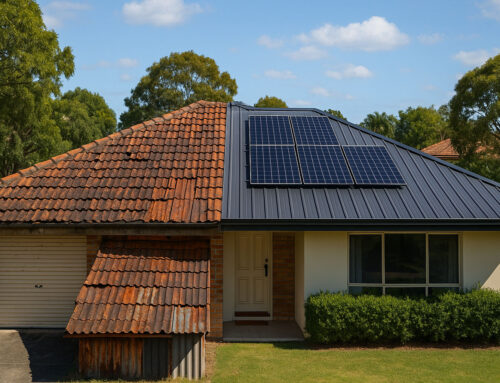When it comes to the condition of your roof, it’s important to know when to replace it to avoid potential problems down the line. In Brisbane, Australia, there are certain signs and indicators that can help you determine when it’s time for a reroof or a metal roof replacement.
Here are some key indicators to look out for:
- Age of Your Roof: The age of your roof is a crucial factor in determining whether it needs to be replaced. Most roofs have a lifespan of around 20 to 25 years, after which they can start to deteriorate.
- Damaged Shingles: Keep an eye out for damaged or missing shingles. If you notice curling, cracking, or bald spots on your shingles, it’s a clear sign that your roof is in need of replacement.
- Leaks and Water Damage: If you notice water stains on your ceiling or walls, it’s a strong indication that your roof has developed leaks. Water damage can lead to significant structural issues and should be addressed promptly.
- Sagging or Drooping Roof: A sagging or drooping roof is a serious problem and should be addressed immediately. It could indicate structural damage or a weakened roof structure.
- Excessive Energy Bills: If you notice a sudden increase in your energy bills, it could be due to poor insulation or ventilation in your roof. A roof replacement can help improve energy efficiency and save you money in the long run.
- Mold and Mildew Growth: Mold and mildew thrive in damp environments, so if you notice any growth or signs of moisture in your attic or on your ceiling, it’s a sign that your roof is allowing water to seep in.
- Sunlight Penetration: If you can see rays of sunlight coming through your roof, it’s a clear indication that there are gaps or holes that need to be addressed.
To determine the condition of your roof, you can conduct a visual inspection yourself or hire a professional roofing contractor to assess its overall health. A professional inspection can provide a more accurate assessment and identify any underlying issues that may not be immediately visible.
When considering a roof replacement, factors such as the type of roofing material, cost, weather conditions, and hiring a reputable roofing contractor should be taken into account. By staying vigilant and addressing any issues promptly, you can ensure the longevity and reliability of your roof in Brisbane.
When Is It Time to Replace Your Roof?
When Is It Time to Replace Your Roof? Is it time to say goodbye to your old roof? Let’s explore the signs that indicate when a roof replacement is necessary. From the age of your roof to damaged shingles, leaks, and even high energy bills, we will discuss the various indicators that may suggest your home in Brisbane needs a new roof. Look out for sagging or drooping structures, signs of mold and mildew growth, and even sunlight sneaking in. Let’s uncover the fate of your roof!
1. Age of Your Roof
The age of your roof is a crucial factor to consider when determining whether it’s time to replace it.
- Most asphalt shingle roofs have a lifespan of 20-25 years.
- Metal roofs can last 40-70 years, depending on the material.
- Tile and slate roofs can last 50-100 years or more.
- Wood shake roofs typically last around 30 years.
To determine the age of your roof, you can check the installation date or consult your home’s records. Look for signs of aging, such as:
- Curling or buckling shingles.
- Missing or damaged shingles.
- Decaying or rotting materials.
- Granules in gutters or downspouts.
If your roof is approaching or surpassing its expected lifespan, it’s advisable to start planning for a replacement. Addressing these issues promptly is essential to avoid more extensive damage and costly repairs later on. Consulting a professional roofing contractor can offer valuable insights and help determine the best course of action for your specific situation.
2. Damaged Shingles
When it comes to determining the condition of your roof, one important factor to consider is the presence of damaged shingles. Damaged shingles can be identified through various signs:
- Cracked or Curling Shingles: Damaged shingles may have cracks or curls, which indicate that they are no longer providing adequate protection for your roof.
- Missing Shingles: If you notice any gaps or missing shingles on your roof, it is a clear sign of damage that needs to be addressed promptly.
- Granule Loss: Shingles have granules on their surface that help protect against UV rays. If you see a significant amount of granules in your gutters or around your property, it could be a sign of damaged shingles.
- Blistering or Warping: Shingles that are blistering or warping indicate moisture damage, which can lead to further issues such as leaks and water damage.
- Moss or Algae Growth: The presence of moss or algae on your roof can indicate moisture problems and damage to the shingles. It is important to address this issue before it causes more damage.
- Dark Spots: Dark spots on your shingles could indicate that they are nearing the end of their lifespan and may need to be replaced.
It is crucial to remember that damaged shingles can compromise the integrity of your roof, potentially resulting in leaks, water damage, and higher energy bills if not dealt with promptly.
3. Leaks and Water Damage
Leaks and water damage are serious issues that indicate the need for roof replacement. Prolonged exposure to water can cause structural damage and compromise the integrity of your roof. It is important to address these issues promptly to prevent further damage to your property.
Signs of roof leaks and water damage include stained ceilings and walls, peeling paint, and the presence of mould or mildew. If you notice these signs, it is crucial to take immediate action.
By addressing leaks and water damage, you can prevent additional problems such as rotting wood, electrical issues, and damage to your belongings. Ignoring these issues can lead to costly repairs in the long run.
To determine the extent of the damage, a visual inspection is recommended. Look for any signs of water stains or moisture on the ceiling or walls. Hiring a professional roofing contractor can provide a more thorough assessment of the damage and offer appropriate solutions.
Consider the severity of the leaks and water damage when deciding whether to replace your roof. If the damage is extensive and affecting multiple areas of your home, roof replacement may be necessary.
It is important to address leaks and water damage promptly to maintain the structural integrity of your home and prevent further complications.
4. Sagging or Drooping Roof
When assessing the condition of your roof, it is important to look out for signs of sagging or drooping. These indicators can suggest significant structural issues that may require immediate attention. Here are some key points to consider:
- Visible sagging or drooping: Inspect your roof from the ground or use binoculars to identify any noticeable sagging or drooping in the structure. This could indicate a problem with the underlying support system.
- Interior signs: Check for any signs of sagging or drooping on the interior of your home, such as bowed ceilings or walls. This may point to a roof issue that needs addressing.
- Water damage: Sagging or drooping roofs are often accompanied by water damage. Look for water stains, discolouration, or mould growth on your ceiling, walls, or attic. These can be signs of a leak caused by a weakened roof structure.
- Excessive weight: Excessive weight, such as from heavy snowfall or the accumulation of debris, can cause a roof to sag or droop. If you notice a sudden change in the appearance of your roof after such events, it is essential to have it inspected.
- Safety concerns: A sagging or drooping roof poses significant safety risks to you and your family. It may lead to a roof collapse, endangering everyone inside the property. To ensure the safety of your household, it is crucial to address this issue promptly.
If you notice any signs of a sagging or drooping roof, it is advisable to contact a professional roofing contractor immediately. They can assess the severity of the problem and provide appropriate solutions to ensure the structural integrity and safety of your home.
5. Excessive Energy Bills
Excessive energy bills can be a sign that it is time to replace your roof. Here are some factors to consider:
1. Poor insulation: If your roof is not properly insulated, it can allow heat or cold to escape from your home, resulting in higher energy bills. Installing a new roof with better insulation can help to lower your energy consumption.
2. Air leaks: A damaged or deteriorating roof can develop gaps or cracks, allowing air to leak in or out of your home. This can cause your HVAC system to work harder to maintain a comfortable temperature, leading to increased energy usage and higher bills.
3. Inefficient roofing material: Older roofing materials may not be as energy-efficient as modern options. Upgrading to a more energy-efficient roofing material, such as metal or reflective shingles, can help to reduce your energy consumption and lower your bills.
4. Poor ventilation: Inadequate ventilation in your loft can trap heat and moisture, leading to increased energy usage. A new roof installation can include proper ventilation to improve energy efficiency and reduce your bills.
5. Age and wear: An aging roof may have worn-out components, such as deteriorated underlayment or damaged flashing, which can contribute to energy loss. Replacing your roof with a new, energy-efficient system can help to minimize energy waste and lower your bills.
By considering these factors and addressing any issues with your roof, you can improve energy efficiency, reduce your energy bills, and ensure a comfortable living environment.
6. Mold and Mildew Growth
Mold and mildew growth can be a significant problem when it comes to your roof. Here are some important factors to consider:
- Mold and mildew thrive in damp and humid conditions. If you notice any growth on your roof, it could be a sign of excess moisture.
- Mold and mildew not only look unsightly but can also damage your roof’s structure and potentially cause health issues.
- If you have mold and mildew growth on your roof, it is crucial to address the underlying cause, such as poor ventilation or a leaking roof.
- Regular roof inspections can help identify mold and mildew growth early on and prevent further damage.
- It is essential to have professionals with the necessary expertise and equipment remove mold and mildew from your roof.
- Preventive measures such as regular roof cleaning and ensuring proper ventilation can help reduce the likelihood of mold and mildew growth.
Remember, dealing with mold and mildew growth promptly is vital for maintaining the integrity of your roof and protecting your home.
7. Sunlight Penetration
The presence of sunlight penetration in your roof can indicate potential issues that may require replacement. Here are some notable factors to consider:
| Sunlight Penetration | Implications |
| Visible rays entering your attic or living space | Indicate gaps, cracks, or holes in your roof, allowing sunlight to pass through. This can lead to water leaks and moisture damage. |
| Deteriorated or damaged roofing materials | May create openings where sunlight penetrates. This highlights the need for roof repair or replacement. |
| Poor insulation or improper installation | Insufficient insulation or inadequate installation can result in sunlight seeping through gaps or poor sealing. This compromises the energy efficiency of your home. |
Addressing sunlight penetration is crucial to prevent further damage and maintain the integrity of your roof. Taking necessary actions, such as repairing or replacing damaged roofing materials, improving insulation, or seeking professional assessment, can help mitigate potential problems.
How to Determine the Condition of Your Roof?
Curious about the condition of your roof in Brisbane? This section will guide you on how to determine the condition of your roof. From conducting a visual inspection to seeking professional advice, we will explore the methods that reveal the true condition of your roof. You will discover the telltale signs and indicators that you should look out for in order to gauge whether it’s time for a roof replacement. Avoid relying on guesswork and let’s thoroughly assess the condition of your roof.
1. Visual Inspection
When conducting a visual inspection of your roof, there are several key indicators to look out for:
- Missing or damaged shingles: Check for cracked, curled, or completely missing shingles, as they can leave your roof vulnerable to leaks and further damage.
- Discoloration: Look for any darker areas or staining on your roof, as this could be a sign of mold, algae, or water damage.
- Granule loss: Examine the gutters and downspouts for an excessive amount of granules, as this could indicate deteriorating shingles that may need to be replaced.
- Sagging or drooping: If you notice any areas of your roof that appear to be sagging or drooping, this could be a sign of structural damage and should be addressed immediately.
- Cracked or damaged flashing: Inspect the flashing around chimneys, vents, and skylights for any cracks or damage, as water can easily seep in and cause leaks.
It’s important to note that a visual inspection is just a preliminary assessment. If you notice any of these issues or are unsure about the condition of your roof, it’s advisable to consult with a professional roofing contractor for a more thorough evaluation.
2. Professional Roof Inspection
When it comes to assessing the condition of your roof, a professional roof inspection is essential. Here are some important aspects to consider during a professional roof inspection:
- Visual inspection: A professional roof inspector will visually examine the roof for any visible signs of damage or wear. They will carefully inspect the shingles, flashing, and gutters to identify any issues, such as cracked or missing shingles, or damaged flashing.
- Infrared scanning: Using specialised tools, a professional roof inspector can perform an infrared scan to detect any hidden moisture or leaks beneath the surface of the roof. This can help identify areas that require immediate attention.
- Interior inspection: A thorough inspection of the interior of your home, including the attic, can provide valuable insights into the overall condition of the roof. Signs of water damage, mold, or mildew growth in these areas may indicate the need for roof repairs or replacement.
- Documentation: A professional roof inspector will document their findings through detailed reports, including photographs and descriptions of any identified issues. This documentation can serve as evidence for insurance claims or future repairs.
- Recommendations: Based on their findings, a professional roof inspector will provide recommendations for necessary repairs or replacement. They can advise on the best course of action to maximise the lifespan and functionality of your roof.
By conducting a professional roof inspection, you can gain a comprehensive understanding of your roof’s condition and make informed decisions regarding any necessary repairs or replacements.
Factors to Consider When Replacing Your Roof
When replacing your roof, there are several crucial factors to consider. We’ll delve into these factors, including the type of roof material and its costs, the impact of weather conditions, and the significance of hiring a professional roofing contractor. Get ready to make an informed decision to provide your home with a strong and reliable roof!
1. Type of Roof Material
Type of Roof Material
To determine the appropriate roof material, it is essential to consider factors such as durability, cost, and aesthetics. Below is a table that compares different types of roof materials:
| Type of Roof Material | Durability | Cost | Aesthetics |
| Asphalt Shingles | Moderate | Affordable | Wide range of colours and styles |
| Metal | High | Moderate to high | Sleek and contemporary |
| Tile | Very high | High | Mediterranean or Spanish appearance |
| Slate | Very high | High | Elegant and timeless |
| Wood Shake | Moderate | High | Natural and rustic |
Each roof material has its advantages and considerations. For example, asphalt shingles are affordable but have a moderate lifespan. Metal roofs are durable and offer a modern aesthetic but can be more expensive. Tile and slate roofs provide exceptional durability and a high-end appearance, but they come with a higher price tag. Wood shake roofs offer a natural and timeless appeal but require regular maintenance. When selecting the appropriate roof material for your home, take into account your budget, climate, and desired appearance.
2. Cost of Roof Replacement
The cost of roof replacement is an important factor to consider when deciding to replace your roof. Several elements contribute to the overall cost of the replacement process. Here is a table that highlights the key factors:
| Factors | Cost Range |
| Type of Roof Material | Varies based on the material chosen. For example, asphalt shingles are generally more affordable compared to metal or clay tiles. |
| Roof Size and Complexity | A larger roof or one with complex architectural designs will require more labour and materials, leading to higher costs. |
| Removal of Old Roofing | If the existing roof needs to be removed before installation, this additional step can increase the total cost. |
| Roof Accessories | Extras such as skylights, chimneys, or additional ventilation systems can add to the overall cost. |
It’s important to note that the cost of roof replacement can vary significantly depending on your location and the specific details of your project. The best approach is to consult with professional roofing contractors who can provide accurate quotes based on your individual needs. Remember to prioritize quality and reliability over the lowest cost to ensure a durable and long-lasting roof that will protect your home for years to come.
When it comes to roof replacement, it’s essential to consider various factors in order to make an informed decision. By understanding the cost implications, you can better plan your budget and choose the most suitable roof material and features for your property.
3. Weather Conditions
When it comes to weather conditions for roof replacement, there are several factors to consider:
- Extreme temperatures: Extreme heat or cold can have a significant impact on the roofing materials. High heat can cause shingles to warp or deteriorate, while freezing temperatures can lead to the formation of ice dams, which can cause water damage.
- Heavy rainfall: Areas with heavy rainfall are more prone to roof leaks and water damage. If your roof has already experienced leaks or if you live in an area with frequent rainstorms, it might be a good time to consider replacing your roof.
- Strong winds: Strong winds, such as those experienced during hurricanes or severe storms, can cause extensive damage to roofs. If your roof has been repeatedly exposed to strong winds or if you notice loose or missing shingles after a storm, it may be necessary to replace your roof.
- Hailstorms: Hail can cause significant damage to roofs, including dents, cracks, and granule loss on shingles. If your roof has been exposed to hailstorms and you notice signs of damage, it may be time for a replacement.
Taking these weather conditions into account when deciding on roof replacement can help ensure that your new roof is better prepared to withstand future weather events. It is always advisable to consult a professional roofing contractor to assess the condition of your roof and provide recommendations based on the weather conditions in your area.
4. Hiring a Professional Roofing Contractor
When it comes to hiring a professional roofing contractor, there are several important factors to consider:
- Experience: Look for a roofing contractor with extensive experience in the industry. They should have a proven track record of successfully completing similar projects.
- License and Insurance: Ensure that the contractor is properly licensed and insured. This will protect you from any liability in case of accidents or damages during the roofing project.
- Written Estimate: Request a detailed, written estimate from the contractor that includes the cost of materials, labour, and any additional expenses. This will help you compare quotes from different contractors.
- Contracts and Warranties: Before hiring a contractor, make sure to review and sign a contract that outlines the scope of work, timelines, payment terms, and any warranties or guarantees on the workmanship or materials used.
By considering these factors, you can ensure that you hire a professional roofing contractor who will provide you with high-quality work and a durable, long-lasting roof for your home.
Frequently Asked Questions
What are the signs that indicate it’s time for a roof replacement?
Some signs that indicate it’s time for a roof replacement include the age of your roof, shingle damage, leaks or water damage, and curling or buckling shingles. These signs can vary but are generally indicators of wear and tear that require attention.
How long do most roofs last before they need to be replaced?
Most roofs are designed to last between 20-25 years. If your roof is approaching or has surpassed this age, it may be time for a replacement. It’s important to keep in mind that this lifespan can vary based on factors such as maintenance, weather conditions, and the quality of the initial installation.
What are the consequences of ignoring signs of roof damage?
Ignoring signs of roof damage can have serious consequences. For example, missing or broken shingles can lead to leaks and further damage to your home. Water stains or damage on your ceiling or walls indicate a roof leak that, if not addressed promptly, can result in significant structural issues. It’s essential to address these signs promptly to prevent further damage and ensure the safety and integrity of your home.
Can a roof repair be sufficient to address signs of wear and tear?
In some cases, a roof repair may be sufficient to address signs of wear and tear. However, this largely depends on the extent of the damage. Consulting a roofing professional for a thorough inspection can help determine whether a repair will be enough or if a roof replacement is necessary to ensure the long-term integrity and functionality of your roof.
How can routine inspections help in identifying roof issues?
Routine inspections conducted by roofing professionals can play a crucial role in identifying potential roof issues. Regular checks, especially after heavy rain or storms, can help identify signs such as water trails, stains on the ceiling or walls, flaking paint, cracked shingles, or other visible damages. These inspections allow for early detection and prompt action, preventing further damage and costly repairs.
Why should I hire a professional roofer for roof replacement or repairs?
Hiring a professional roofer provides several benefits. Firstly, roofing professionals have the expertise and experience to assess the state of your roof accurately and provide appropriate solutions. They can seamlessly prevent leaks and ensure proper drainage to keep water out. Additionally, professional roofers can offer practical tips for maintenance and provide high-quality installation services, giving you peace of mind and a sense of security for your home.
Contact Brisbane Roofing Co for all your Brisbane Roofing Needs.





